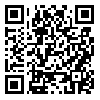1. Fotokian Z, Ghaffari F, Keyhanian Sh. The Relation of Stressful Life Events and Cancer in Refers to Oncology Unit in Ramsar Imam Sajad Hospital. Scientific Journal of Hamadan Nursing and Midwifery Faculty. 2008;16 (1): 33-44.
2. Fobair P, Cordoba CS. Scope and magnitude of the cancer problem in psychosocial research. Psychosoc Asp Cancer Raven N Y. 1982;9-92.
3. Biondi M. Clinical research strategies in psychoimmunology: A review of 46 human research studies (1972-1992). Stress Immune Syst Psychiatry. 1995.
4. Blaney PH. Psychological considerations in cancer. Behav Med Biopsychosoc Approach Hillsdale NJ Lawrence Erlbaum Assoc Publ. 1985;102: 11-22.
5. Spiegel D. Mind Matters-Group Therapy and Survival in Breast Cancer. N Engl J Med. 2001;345(24):1767-8. [
DOI:10.1056/NEJM200112133452409]
6. Gordon KW. The multidimensionality of peer victimization and patterns of relating in attachment. ProQuest; 2008.
7. Berant E, Mikulincer M, Florian V. Attachment style and mental health: A 1-year follow-up study of mothers of infants with congenital heart disease. Personality and Social Psychology Bulletin. 2001;27(8):956-968. [
DOI:10.1177/0146167201278004]
8. Davila J, Burge D, Hammen C. Why does attachment style change? J Pers Soc Psychol. 1997;73(4):826-38. [
DOI:10.1037//0022-3514.73.4.826]
9. Nori R, Dargahiyan R, Abdollhi M, Sangari A. Relationship between attachment styles , maladaptive schemas and cope with stress. The fifth seminar on mental health, Tehran, Iran: Shahed University; 2009. [Persian]
10. Bowlby J. A secure base: Clinical applications of attachment theory. Vol. 393. Taylor & Francis; 2005.
11. Besharat M, Farhadi M, Gilani B. The Relationship between attachment style and homesickness. Journal of psychology Tabriz University. 2006; 1(2-3):33-56. [Persian]
12. Descutner CJ, Thelen MH. Development and validation of a Fear-of-Intimacy Scale. Psychol Assess J Consult Clin Psychol. 1991;3(2):218-225. [
DOI:10.1037//1040-3590.3.2.218]
13. Thelen MH, Vander Wal JS, Thomas AM, Harmon R. Fear of intimacy among dating couples. Behav Modif. 2000;24(2):223-240. [
DOI:10.1177/0145445500242004]
14. Yousefali A , Nisi A, Yousefi N, Nabavi Hesar J .Compare the mental-hardness, Sensation- seeking, A personality types Non-toxic and toxic, among men and women with cancer and normal people the psychiatric counseling centers in Ahvaz. Journal of education and psychology. 2004; 3:110-120. [Persian]
15. Mosher CE, Danoff-Burg S. A review of age differences in psychological adjustment to breast cancer. J Psychosoc Oncol. 2006;23(2-3):101-114. [
DOI:10.1300/J077v23n02_07]
16. Patrick S, Sells JN, Giordano FG, Tollerud TR. Intimacy, differentiation, and personality variables as predictors of marital satisfaction. Fam J. 2007;15(4):359-367. [
DOI:10.1177/1066480707303754]
17. Cooper ML, Agocha VB, Sheldon MS. A motivational perspective on risky behaviors: The role of personality and affect regulatory processes. J Pers. 2000;68(6):1059-1088. [
DOI:10.1111/1467-6494.00126]
18. Maher CF, Hussell T, Blair E, Ring CJ, Openshaw PJ. Recombinant respiratory syncytial virus lacking secreted glycoprotein G is attenuated, non-pathogenic but induces protective immunity. Microbes Infect. 2004;6(12):1049-1055. [
DOI:10.1016/j.micinf.2004.07.001]
19. Ottrin P. Karel S. Miller BD. Attachment and children's asthma experience. Journal of Allergy and clinical Immunology 2003; 1.5(2): 193-204
20. Karsill. Psychological aspects of asthma. Child development. 1980; 40(1): 123-127.
21. Cassibba R, van IJzendoorn MH, Bruno S, Coppola G. Attachment of mothers and children with recurrent asthmatic bronchitis. J Asthma. 2004;41(4):419-431. [
DOI:10.1081/JAS-120033984]
22. Schmidt SD, Blank TO, Bellizzi KM, Park CL. The relationship of coping strategies, social support, and attachment style with posttraumatic growth in cancer survivors. J Health Psychol. 2012;17(7):1033-1040. [
DOI:10.1177/1359105311429203]
23. Khavaninzadeh M. Comparing of attachment styles and Religious orientation of internal and external in students. [MSc Thesis]. [Tehran]: Iran: Tarbiat Modares University; 2005. [Persian]
24. - Falahzadeh H, Farzad V, Falahzadeh M. A study of the Psychometric Characteristics of Fear of Intimacy Scale (FIS) . rph. 2011; 5 (1) :70-79. [Persian] [
https://rph.khu.ac.ir/article-1-7-fa.html]





